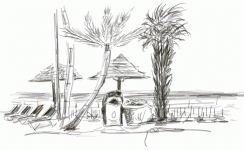You are using an out of date browser. It may not display this or other websites correctly.
You should upgrade or use an alternative browser.
You should upgrade or use an alternative browser.
Wants to learn art
- Thread starter Jazzy
- Start date
- Joined
- Jun 10, 2015
- Messages
- 33,429
- Age
- 58
- Gender
- Female
- Religious Affiliation
- Lutheran
- Political Affiliation
- Conservative
- Marital Status
- Married
- Acceptance of the Trinity & Nicene Creed
- Yes
My best advice is to just start drawing every day. The more we draw, the more we "see" the things we never saw before such as lighting, colors, composition, etc....
SetFree
Well-known member
- Joined
- Oct 7, 2022
- Messages
- 504
- Location
- USA
- Gender
- Male
- Religious Affiliation
- Non-Denominational
- Political Affiliation
- Conservative
- Acceptance of the Trinity & Nicene Creed
- Yes
It's nice to have a God-given talent in art, but actually anyone can learn it (as with most things if one is determined and disciplined enough). My first college major was Commercial Art, and I went through a year of classes, but I didn't stick with it; saw the need to get a degree closer to my military experience (aviation) for my job.What is your best advice for someone who wants to learn art?
1. I recommend at first learning how to 'see' by drawing everyday objects. Start with simple objects around the house, like a mustard jar, apple, orange, even a pencil laying on a table, etc.
2. The way I taught my boys how to draw was actually to draw an apple and then tell them to color it with their crayons. The natural tendency for most is to color the apple all the same color of basic red (called 'local' color), which they did. Then I got them to look closer at the apple, and notice that much of the bottom portion was in shadow and thus a darken tone of red, and even there was a slight yellow blotch on the top in one corner.
I told them don't draw or paint what your 'mind' tries to tell you how an apple should look. Everyone knows an apple is red, so they ten to make the whole rendering red all over. Draw or paint what your eye 'actually sees', like a camera. This is kind of difficult to do at first, but it is the beginning of developing what is called the 'artist eye'. Some naturally have it, others must learn it.
Move your hand back from the lead end of the drawing tool, get loose when sketching. Don't be concerned if you don't connect all the lines in your drawing, it's actually better to leave some disconnected (the viewer's mind will automatically connect them). I've always used short fast motions when sketching. So that is a long ways away from trying to 'outline' what I draw, because anyone can buy a coloring book with clear, thick outlines of objects that is lifeless. Want your drawings to have life, then don't think in 'outlines'.
3. Learn perspective. In drawing class, they teach you about perspective and the vanishing point, etc. It may sound boring, but it is actually pretty essential if you ever want to develop into major graphic design work and landscapes. I had 2 years of mechanical drawing (drafting) in high school, and another year of engineering graphics in college. That pretty much training my sense of perspective to where rarely do I have to draw a vanishing point into the sketch prep. It also helps to 'see' angles of various objects that are near each other, like for a still life.
4. Color Theory is another area that the artist must get a grasp on. Lot of it has to do with physics too like perspective does.
5. Learn to paint in oils. Most professional art classes will have you start using oils, because they are very forgiving. They are long drying, so you can correct mistakes easily. And though software art programs are great tools, they still have yet to capture much of the feeling of painting in real oils. Watercolors is a different ball of wax, because it is more technique driven I think. With oils, you get to see the strength of color you're laying down right then (usually). But in watercolors, a color will dry lighter in tone most of the time.
I highly recommend an art instructor, if serious about making it a career. If not, then most communities have seminars and art workshops where you can pick up a lot.
- Joined
- Jul 13, 2015
- Messages
- 15,013
- Location
- Somewhere Nice Not Nice
- Gender
- Male
- Religious Affiliation
- Christian
- Marital Status
- Married
- Acceptance of the Trinity & Nicene Creed
- Yes
I remember as a teenager I did an art class during a family vacation. The teacher was very much the creative arty type (as you'd expect, given the course topic) and spent a lot of her time telling me to stop drawing lines. My natural tendency was to draw lines to outline things, where she was wanting me to draw shaded areas. A face isn't surrounded by lines, but as soon as you draw a line to try and define the face you fail to correctly define the face.
I'm not, and never have been, particularly good at drawing and painting and the like. I understand technical concepts like perspective, vanishing points etc and can make technical drawings and doodles of wacky shapes that mostly work, but getting colors and shades right isn't something I ever really got to.
I'm not, and never have been, particularly good at drawing and painting and the like. I understand technical concepts like perspective, vanishing points etc and can make technical drawings and doodles of wacky shapes that mostly work, but getting colors and shades right isn't something I ever really got to.
- Joined
- Jun 10, 2015
- Messages
- 33,429
- Age
- 58
- Gender
- Female
- Religious Affiliation
- Lutheran
- Political Affiliation
- Conservative
- Marital Status
- Married
- Acceptance of the Trinity & Nicene Creed
- Yes
I remember as a teenager I did an art class during a family vacation. The teacher was very much the creative arty type (as you'd expect, given the course topic) and spent a lot of her time telling me to stop drawing lines. My natural tendency was to draw lines to outline things, where she was wanting me to draw shaded areas. A face isn't surrounded by lines, but as soon as you draw a line to try and define the face you fail to correctly define the face.
I'm not, and never have been, particularly good at drawing and painting and the like. I understand technical concepts like perspective, vanishing points etc and can make technical drawings and doodles of wacky shapes that mostly work, but getting colors and shades right isn't something I ever really got to.
Although the teacher was trying to encourage you to do something different than what you were used to, she was wrong in saying that you shouldn't use lines. In Illustrations, you use more lines to define things because for advertising purposes, you can't always afford printed pieces with shading so line drawings are necessary. You would have been a good illustrator!
SetFree
Well-known member
- Joined
- Oct 7, 2022
- Messages
- 504
- Location
- USA
- Gender
- Male
- Religious Affiliation
- Non-Denominational
- Political Affiliation
- Conservative
- Acceptance of the Trinity & Nicene Creed
- Yes
So this discussion has sunken into bad art teachers that say to not draw lines?
Not drawing 'outlines' like a coloring book is a lot different idea than saying not to draw lines. It should be common sense that all... drawings have to use lines.
1. 'outlines' example, hard edges:

2. hard lines less uniform, some lines broken, some lines thicker, some thinner:

Not drawing 'outlines' like a coloring book is a lot different idea than saying not to draw lines. It should be common sense that all... drawings have to use lines.
1. 'outlines' example, hard edges:

2. hard lines less uniform, some lines broken, some lines thicker, some thinner:

Last edited:
- Joined
- Jul 13, 2015
- Messages
- 15,013
- Location
- Somewhere Nice Not Nice
- Gender
- Male
- Religious Affiliation
- Christian
- Marital Status
- Married
- Acceptance of the Trinity & Nicene Creed
- Yes
Although the teacher was trying to encourage you to do something different than what you were used to, she was wrong in saying that you shouldn't use lines. In Illustrations, you use more lines to define things because for advertising purposes, you can't always afford printed pieces with shading so line drawings are necessary. You would have been a good illustrator!
I guess I didn't explain the context very well. In an illustration you need lines but she was trying to get me to see shades and colors rather than outlines of everything, drawing hard lines to define shapes and then wondering why nothing looked quite like it should.
I might make a good illustrator, but don't imagine I'm going to be selling paintings any time soon.
- Joined
- Jun 10, 2015
- Messages
- 33,429
- Age
- 58
- Gender
- Female
- Religious Affiliation
- Lutheran
- Political Affiliation
- Conservative
- Marital Status
- Married
- Acceptance of the Trinity & Nicene Creed
- Yes
I guess I didn't explain the context very well. In an illustration you need lines but she was trying to get me to see shades and colors rather than outlines of everything, drawing hard lines to define shapes and then wondering why nothing looked quite like it should.
I might make a good illustrator, but don't imagine I'm going to be selling paintings any time soon.
Oh, I got it. That's why I said, "Although the teacher was trying to encourage you to do something different than what you were used to". She was trying to get you to attempt a different technique and it's really difficult to do if you aren't used to it.
- Joined
- Jul 13, 2015
- Messages
- 15,013
- Location
- Somewhere Nice Not Nice
- Gender
- Male
- Religious Affiliation
- Christian
- Marital Status
- Married
- Acceptance of the Trinity & Nicene Creed
- Yes
Oh, I got it. That's why I said, "Although the teacher was trying to encourage you to do something different than what you were used to". She was trying to get you to attempt a different technique and it's really difficult to do if you aren't used to it.
I naturally think in lines and figures so I really struggled with it. She was a very talented artist and I think she was a good teacher. But even she couldn't make a silk purse from a sow's ear...
Lucian Hodoboc
Well-known member
- Joined
- Jan 1, 2019
- Messages
- 1,405
- Location
- Eastern Europe
- Gender
- Male
- Religious Affiliation
- Theist
- Political Affiliation
- Conservative
- Marital Status
- Single
- Acceptance of the Trinity & Nicene Creed
- No
You're very talented. When did you draw these?So this discussion has sunken into bad art teachers that say to not draw lines?
Not drawing 'outlines' like a coloring book is a lot different idea than saying not to draw lines. It should be common sense that all... drawings have to use lines.
1. 'outlines' example, hard edges:
View attachment 1900
2. hard lines less uniform, some lines broken, some lines thicker, some thinner:
View attachment 1901
SetFree
Well-known member
- Joined
- Oct 7, 2022
- Messages
- 504
- Location
- USA
- Gender
- Male
- Religious Affiliation
- Non-Denominational
- Political Affiliation
- Conservative
- Acceptance of the Trinity & Nicene Creed
- Yes
I didn't draw those. Those are just examples off the Internet.You're very talented. When did you draw these?
But I did... draw the following when I went on vacation recently to the east coast U.S. It was a rough sketch view at poolside at the hotel I stayed at, looking out towards the ocean...

Last edited:
Lucian Hodoboc
Well-known member
- Joined
- Jan 1, 2019
- Messages
- 1,405
- Location
- Eastern Europe
- Gender
- Male
- Religious Affiliation
- Theist
- Political Affiliation
- Conservative
- Marital Status
- Single
- Acceptance of the Trinity & Nicene Creed
- No
Nice. You should definitely post more of your works.I didn't draw those. Those are just examples off the Internet.
But I did... draw the following when I went on vacation recently to the east coast U.S. It was a rough sketch view at poolside at the hotel I stayed at, looking out towards the ocean...
View attachment 1902
SetFree
Well-known member
- Joined
- Oct 7, 2022
- Messages
- 504
- Location
- USA
- Gender
- Male
- Religious Affiliation
- Non-Denominational
- Political Affiliation
- Conservative
- Acceptance of the Trinity & Nicene Creed
- Yes
Thanks.Nice. You should definitely post more of your works.
I really don't do much art anymore. I just did that loose sketch to see how the ArtRage software program would work. My son said I should do a sketch of the place.
- Joined
- Jul 13, 2015
- Messages
- 15,013
- Location
- Somewhere Nice Not Nice
- Gender
- Male
- Religious Affiliation
- Christian
- Marital Status
- Married
- Acceptance of the Trinity & Nicene Creed
- Yes
What is your best advice for someone who wants to learn art?
To go back to the original question, my best advice would be not to hire me as your teacher
